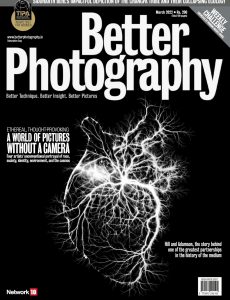
Better Photography – March 2022
English | 100 pages | pdf | 59.97 MB
In the Reading of Photographs
How does one train the eye to see? In all my years of looking at photographs, trying to bring to reality the images within my mind, and sometimes being asked for opinions or advice on a set of photos, I’ve realised something important. An image is always a selective slice of reality that may not be very real at all. A photographer decides what must be left out, and what needs to reside within a frame.
Any photograph, thus, is a very small portion of a larger truth, and consequently, can just as much be a lie. Every lie also contains a veiled grain of truth in it. How much of the truth reaches the viewer depends on the subject giving in, and the photographers experience, skill, and readiness, to capture it.
The frame, in its most literal sense, is a boundary, an enclosure. More figuratively, everything we absorb, learn, and experience, about photography, and just as equally, in life, form boundaries. Humans, animals, life itself, does not remain happy within walls and cages. It is in our nature to explore, to test those limits. How much we are given to exploring and accepting discoveries depends on our formation from childhood, and our conformity to societal mores. For instance, I’ve noticed that most Indians are less ready than other cultures to take significant risks. Or to choose a radically different path. Readiness to accept is the key. To accept more, expect less.
Expectations form a large part of things. We expect to be noticed and don’t mind putting on a face for the show. We expect to be liked by a majority rather than a minority. More aptly, we normally don’t wish to move against expectations … not as long as we can rationalise and justify it to ourselves. Expectations tell us how to compose ourselves, and our frames. Say and do the right things. Be polite and gentle. Watch the lines, keep horizons level. Maintain the rules! The rules of composition come from what, and how much of what, is most pleasing
to the majority. It can be broken. There was a point where I proposed to students that they break the rules, but only after knowing what those rules are in the first place. Know your boundaries. Then break them.
Now, I wonder if that advise was a good one. Learning must always liberate, not limit. I have been watching interesting but unguided photographers become boring replicas of each other because they learnt to conform. I enjoy getting into the minds of photographers through their images. Who were they? What are they like? How do they think? What do they feel? Masterful photographers are easier to read because they are liberated by their work. So are untrained but good, seeing eyes, because they see truthfully, untainted by their own expectations, or that of others. The minute they learn too much, all sense of original emotion tends to move out of their pictures. Their photos become smartly composed, but veiled. Indistinct in a sense. Half-truths. They get liked by a majority. But they will not be remembered as unique.
I’ve been extremely fortunate to discover and be influenced by some extraordinary photographers during the course of my own explorations on the subject. In my early, formative years, there were the legendary Indian photographers, some of whom I have had the privilege to n1eet and speak with. From famed pictorialists like C Rajagopal, to brilliant wildlife photographers like E Hanumantha Rao and TN A Perumal, to the quiet, meditative reflections of Ashvin Mehta, to those who saw the history of our nation unfolding like Homai Vyaravalla and Pranlal Patel, and photographers of humanity in all its magnificent forms in India, Raghubir Singh, Jyoti Bhatt, Raghu Rai and S Paul. I found Saul Leiter in 2003, Francesca Woodman in 2007. And the joy of Andre Kertesz dawned on me in 2009. Seydou Keita in 2018. I stumbled upon them quite by chance, not because I was particularly pointed in their direction. They were well known by then, but to me, discoveries for myself.
I know them now because of the nature of their truths. Their photographs are so rich and alive with promise.
K Madhavan Pillai [email protected]
Download from: